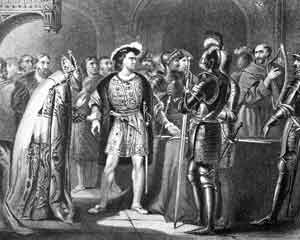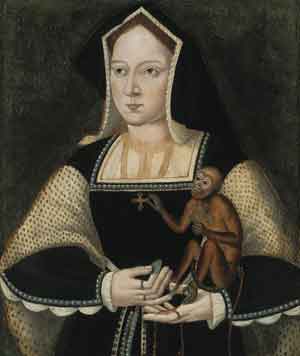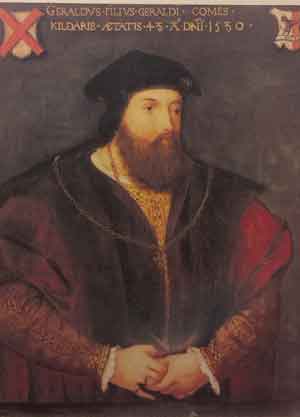By Henry A. Jefferies

Generations of students have learned about ‘Silken Thomas’ FitzGerald and his ill-fated rebellion of 1534/5 but were taught nothing about the involvement of his foster-mother, his wife or his stepmother in what was one of the most important events in Irish history. Tudor Ireland, it seemed, was most definitely a ‘man’s world’ in which women’s primary role was to give birth to an heir and a ‘spare’.
THE FOSTER-MOTHER

The airbrushing of women from the history of Tudor Ireland began with Edmund Campion’s A historie of Ireland written in the yeare 1571. The book is especially interesting for its account of the Kildare rebellion of 1534/5. According to Campion, the rebellion began with Henry VIII’s vice-deputy in Ireland, Lord Thomas FitzGerald, heir to the 9th earl of Kildare, giving up the sword of state and declaring that
‘I am none of Henryes deputy, I am his foe, I have more mind to … meete him in the field than to serve him in office. If all the hearts of England and Ireland that have cause thereto, would joyne in this quarrel (as I trust they will) then should he be a by-word (as I trust he shall) for his heresie, lechery and tyranny, wherein the age to come may skore him among the auncient princes of most abhominable and hatefull memories …’
Campion referred to ‘many other slanderous and foule termes’ with which FitzGerald abused Henry and Anne Boleyn, the new queen, in highly personal terms. These seem to have been circulated in written form because, according to a contemporary report by Eustace Chapuys, the imperial ambassador to the court of Henry VIII, the king was grievously upset on reading them. The personal abuse directed against the king from the start of the rebellion shows that it was never intended to be a simple ‘gesture of protest’, as some historians later claimed. The very earliest surviving report about the rebellion from Ireland informed Thomas Cromwell, Henry VIII’s chief minister, that the rebels condemned the king as ‘accursed’ for forsaking the Catholic Church, and they declared that they would serve the pope against him.

Campion made no reference to Thomas’s foster-mother, Dame Janet Eustace, and her role in the rebellion, yet John Alen, one of the most senior English officials in Ireland at the time, informed Cromwell that Janet was ‘by all probable conjecture … the chief councillor and stirrer of this inordinate rebellion’. Alen reiterated that Janet was ‘the great causer’ of the rebellion and that her eldest son, James Delahide, was ‘the greatest traitor next to Thomas [FitzGerald]’. Richard Stanihurst, using his father’s archive, wrote that Lord Leonard Grey, Henry VIII’s deputy in Ireland, was convinced that Janet’s son, James, was ‘the onely bruer of all this rebellion … set on by his parents, and namely by his mother’. Why Campion excluded Janet from his Historie is unclear; perhaps he simply didn’t know how to integrate a female rebel into his narrative.
After Janet and her husband were captured by English soldiers, they were imprisoned in Dublin Castle. The king’s deputy tried to entice her ‘by fayre means’ to implicate her husband in the rebellion; when that didn’t work, she was ‘menaced to be put to death, or to be rackt and so with extremitie to be compelled’. She did not capitulate, however, and her husband was freed, but she herself died ‘with these continual stormes heartbroken’ after twelve months of imprisonment and ‘duress’. Janet’s body was taken to the Franciscan friary in Dublin, but the king’s deputy prevented her from being buried, declaring that ‘the carkasse of one who was the mother of so arrant an archtraytor ought rather to be cast out on a dunghill to be carion for ravens and dogs to gnaw upon than to be layd in any Christian grave’. In fact, she was buried after four or five days ‘in this plight’, but the hostility directed towards her is obvious.
Dame Janet was an unlikely rebel leader. Her father, Roland Eustace, Baron Portlester, was one of the leading lords of the English Pale, and one of her sisters, Alison Eustace, was the first wife of the 9th earl of Kildare. Her husband, Sir Walter Delahide, was a leading member of the Pale gentry. She had been the foster-mother of Lord Thomas FitzGerald, the rebel leader, as well as his aunt. The fact that Thomas’s mother died when he was a child must have made his relationship with his foster-mother all the stronger.
Like all Tudor rebellions, the Kildare revolt was not monocausal, yet it would be perverse to deny that Janet’s participation in the Kildare rebellion was inspired by her hostility to Henry VIII’s Reformation. Nothing else would plausibly explain why a lady of her background would risk the lives of her three sons, one of whom was a priest, her husband’s life and her own on such a very high-stakes gamble as a rebellion against the Crown. Colmán Ó Clabaigh pointed out to me that Janet’s father, Baron Portlester, founded the Observant Franciscan friary at Kilcullen. Growing up with such strong Franciscan influences would certainly help to explain Dame Janet’s commitment to the Catholic faith.
THE WIFE

Frances Fortescue was the wife of Lord Thomas FitzGerald and remained with him throughout the rebellion until its virtual collapse in May 1535. At that point FitzGerald condemned her for being English and sent her home, but his ruse didn’t succeed. Frances was apprehended, taken to England and placed under house arrest in the custody of her brother-in-law, Lord Wentworth, in Suffolk. Ominously, Wentworth received instructions from Cromwell in February 1540 to send Lady Frances to him in ‘secret sort’. As it happens, she was gravely ill and died a couple of weeks later. Why Cromwell should want Frances sent to him in ‘secret sort’ is nowhere recorded.
However, Frances’s father, Sir Adrian Fortescue, had been attainted along with Cardinal Reginald Pole, the cardinal’s mother Margaret, countess of Salisbury, his brother Henry, Lord Montagu, and a very long list of other leading Catholic dissidents in 1539, and was executed shortly afterwards. He was clearly a man of strong Catholic convictions. He knew the cardinal’s mother, the countess of Salisbury, from when he was in attendance on Catherine of Aragon and she was Princess Mary’s governess. Frances’s support for her husband’s rebellion in 1534/5 is all the more intelligible in the light of her father’s commitment to Catherine and Mary, and to the Catholic faith. Her premature death probably saved her from being executed like her father.
THE STEPMOTHER
Lord Thomas’s stepmother, Countess Elizabeth Grey, had been one of Princess Mary’s maids of honour and had attended Queen Catherine at the Field of the Cloth of Gold in 1520, alongside Sir Adrian Fortescue. That helps to explain how her stepson, Thomas, and Adrian’s daughter, Frances, subsequently met and married each other. Elizabeth was Cardinal Pole’s kinswoman and knew his mother, the countess of Salisbury, very well.
Also in the entourage of the queen and Princess Mary was Thomas, Baron Darcy of Templehurst, and his cousin John, Lord Hussey, Princess Mary’s chamberlain. Hussey’s second wife, Anne, was one of Mary’s attendants until being lodged in the Tower of London for several months for calling Mary a ‘princess’ during the Kildare rebellion. During the rebellion both Darcy and Hussey assured the imperial ambassador, Eustace Chapuys, that if Emperor Charles V declared war on Henry VIII there would be an ‘insurrection by the [English] people who would be joined immediately by the nobility and clergy’. In September 1533 Bishop John Fisher of Rochester had already urged the emperor to send an invasion force to England to spark off a popular rebellion to topple Henry. According to Chapuys, innumerable people from many ranks of English society were ‘deafening’ him with similar calls. It is likely that Lord Thomas FitzGerald, through his wife and/or stepmother, was aware of such developments.
One can only speculate as to whether or not Countess Elizabeth was aware that her husband, Garret Óg Fitzgerald, the 9th earl of Kildare, had drawn up contingency plans for a rebellion after he was summoned by Henry VIII in March 1534, although it is very hard to believe that she had no idea of what her husband was thinking. Richard Stanihurst assured his readers that the countess and her husband had an extraordinarily close relationship:
‘This noble man was so well affected to his wife, the Lady Gray, that he woulde not at any tyme buy a sute of apparel for himself but he woulde sute her with the same stuffe. Which gentlenesse she recompenced with equall kindenesse. For after that he deceased in the Tower she did not only ever after live as a chast and honourable vidue, but also nightly before shee went to bed she would resort to his picture, and there with a solemn congee, she woulde bid hir lord goodnight. Whereby may bee gathered with howe great love shee affected his person, that had in such price his bare picture.’
This charming vignette about his parents may have been recounted to Stanihurst by Gerald FitzGerald, 11th earl of Kildare, while he employed the scholar as tutor to his children. His parents had certainly been in love and had married without the consent of Elizabeth’s father and without her dowry. While Countess Elizabeth was not personally implicated in the rebellion, one of her ladies-in-waiting, Rose Eustace, was incarcerated in Dublin Castle along with Dame Janet Eustace, who was possibly her aunt.
THE IMPLICATIONS
After Steven Ellis highlighted the religious dimension of the Kildare rebellion in a paper published in 1976, a new consensus emerged that it was never intended to be a rebellion at all—that it was simply a ‘gesture of protest’ that accidentally escalated into a rebellion after the 9th earl of Kildare was arrested. In a paper published in 2004/5, however, I showed that the rebellion was already well under way before news of the earl’s arrest had time to reach Ireland, and I reaffirmed that religion had been central to the planning for the rebellion.
To help win support from English religious conservatives, the Irish rebels chose as their chief ideologue Dr John Travers, an English priest who had only recently resigned as an Oxford don in reaction to religious developments at home and took up the position of dean in St Patrick’s Cathedral, Dublin. Travers wrote a book in favour of the papacy against Henry VIII’s pretensions. He supported the Kildare rebellion enthusiastically and was subsequently executed for his involvement in it. Also prominent in the rebellion and privy to it before its outbreak was another English cleric, George Cromer, the archbishop of Armagh and primate of all Ireland. Cromer had been one of Henry VIII’s chaplains while the king was composing the anti-Lutheran Assertio, and he was promoted to Armagh at the same time as Pope Leo X granted Henry the title of ‘Defender of the Faith’ in acknowledgement of the Assertio. Cromer’s archdeacon, Cormac Roth, was one of FitzGerald’s chief councillors. Another chief councillor was FitzGerald’s chaplain, Archdeacon Cathal McReynolds, who travelled to Rome and persuaded the pope to give his blessing to the rebellion.
While in the service of Catherine of Aragon and Mary, Countess Elizabeth would have been familiar with William Peto, the confessor to the queen and princess. Peto was the provincial of England’s Observant Franciscans and an outspoken critic of Henry’s marital adventures, for which he was first imprisoned and then sent into exile. Peto’s successor, Francis Faber, travelled to Dublin immediately prior to the Kildare rebellion after promising Chapuys, the imperial ambassador, that he would ‘brew up there all he could for the preservation of the holy see’.
Religion was clearly a central aspect of the Kildare rebellion, and in that context, and against the background of contemporary developments in England, the involvement of Dame Janet Eustace in the rebellion is readily explicable as a reflection of her opposition to Henry VIII’s increasingly radical religious policies. Lady Frances Fortescue personifies the links between English resistance to the Tudors’ Reformations and Irish resistance. She came very close to losing her life, as her father did for defying the dictates of Henry VIII. Countess Elizabeth Grey’s role is more nebulous, but she was closely linked with the leading Catholic conspirators associated with Catherine of Aragon and Mary, and she was a kinswoman of Cardinal Pole. By ignoring such women we have been left with an incomplete understanding of our history. The Kildare rebellion can no longer be regarded as a reactionary gesture in a colonial backwater but as an important event that was influenced by women as well as men at the heart of the debate about Henry VIII’s Reformation.
Henry A. Jefferies is a Research Associate in History at Ulster University.
Further reading
S.G. Ellis, ‘The Kildare rebellion and the early Henrician Reformation’, Historical Journal 14 (1976).
H.A. Jefferies, ‘The Kildare revolt: accident or design?’, Journal of the County Kildare Archaeological Society 19 (2004–5).
H.A. Jefferies, ‘Women and the Reformation in Tudor Ireland’, Journal of Ecclesiastical History 73 (2022).
R. Stanihurst, ‘The description and chronicles of Yreland from the first originall until the yeare 1547’, in R. Holinshed, The chronicles of England, Scotlande and Irelande (London, 1577).
